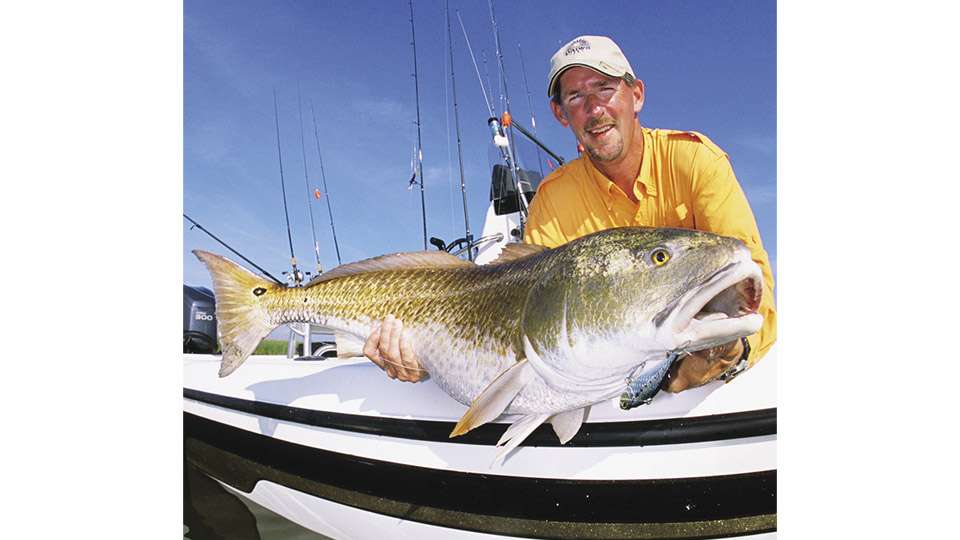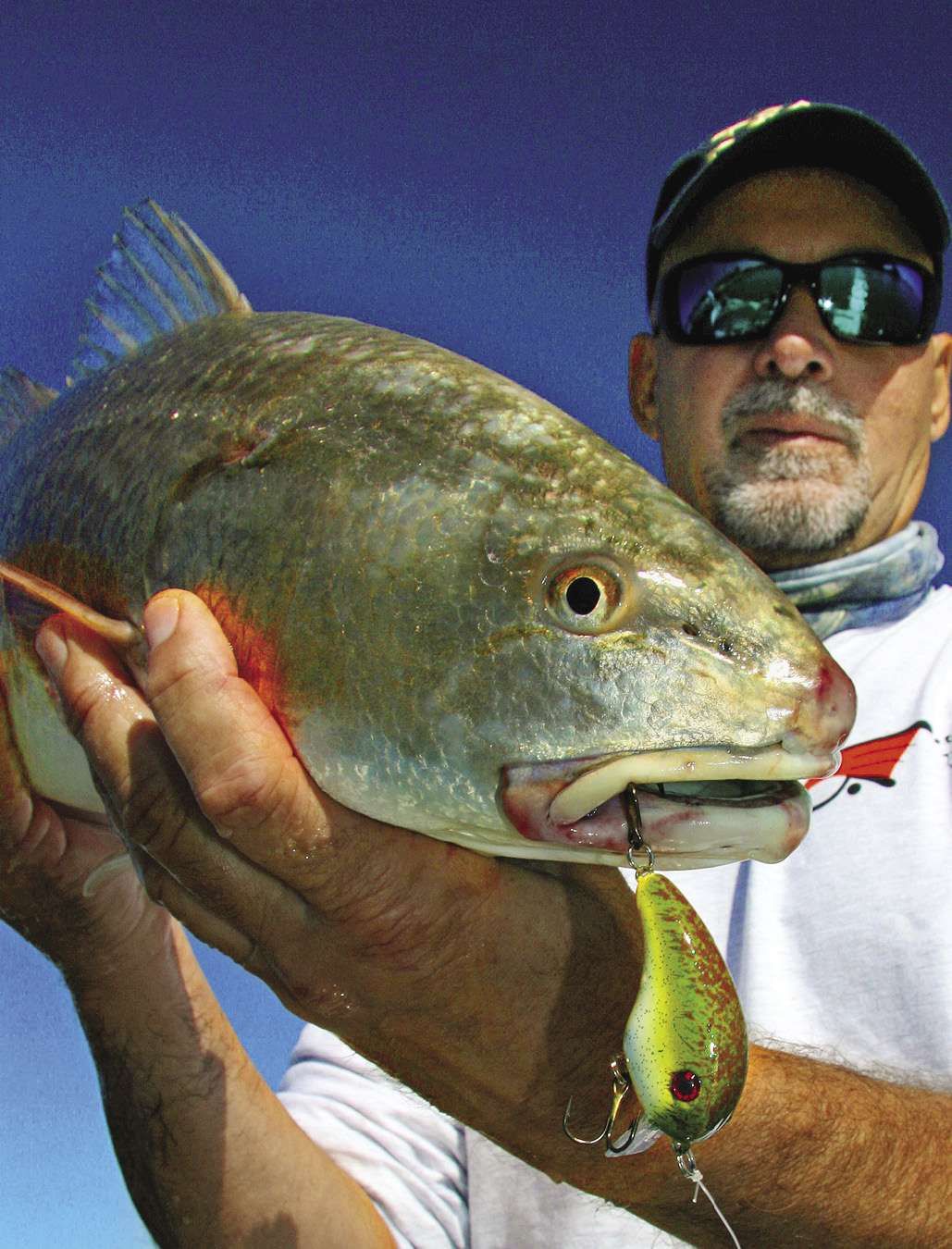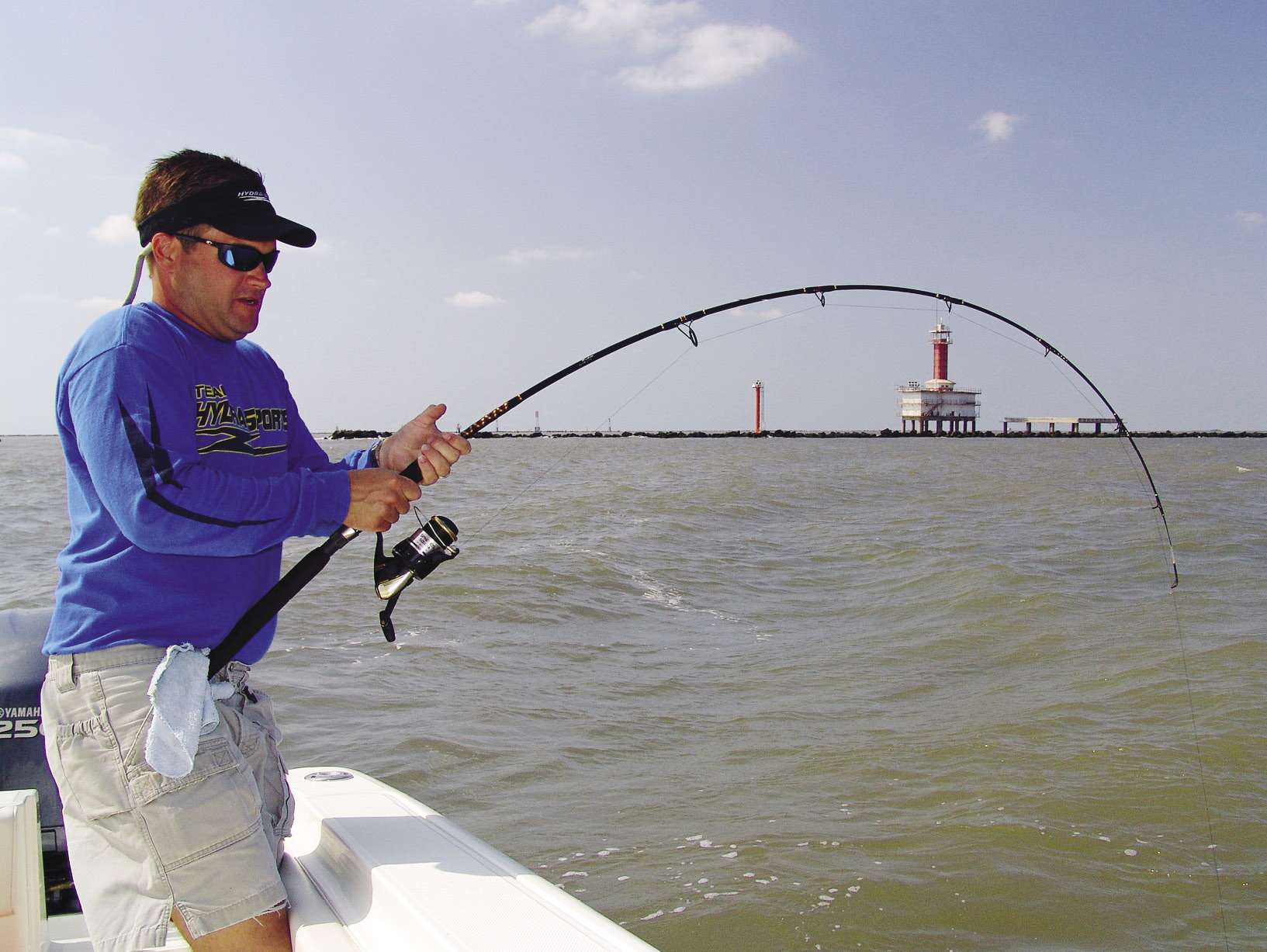
Sight fishing is probably the most common strategy for redfish pursuits; just look for fish, their shapes or shadows, their wakes or “nervous water,” and cast accordingly. However, when weather, tides and/or habitat eliminate the visual element, anglers who understand the tactics of deep water recon can keep the lines tight even when they can’t see their quarry.
For clarity, we’re talking about tournament-size “slot” fish — those fitting into a state’s minimum and maximum size limits. Mature redfish of 20 pounds or better roam near shore reefs and gather near coastal passes each fall for spawning. For simplicity, we’ll stick to reds that make inshore and coastal waters their home.
Deep water redfishing — generally, deeper than 10 feet — relies more on deductive reasoning than direct observation. What’s the water doing? What does local structure offer redfish? Where’s the food? Saltwater neophytes can eventually figure it out, but anyone with fundamental bass skills will more quickly decipher the riddle.
In the coastal marshes of northeast Florida, Terry Lacoss, former bass tournament angler turned saltwater guide, often employs his freshwater background to find structures that attract redfish. When high tides conceal inshore spots, or when the skinny water bite is tough, he’ll use his electronics to locate submerged oyster reefs that never see the sun. Lacoss has marked many such spots on his GPS, and anglers willing to flip on the sonar and go hunting will find their share of similar honey holes.
On Florida’s west coast, Capt. Ray Van Horn, another bass alumnus now guiding along the coast, said: “Bass and redfish have many similarities, so guys who have a bass background have an advantage in terms of perspective.”
For example: Van Horn and his tournament partner C.A. Richardson of St. Petersburg, Fla., once marked a bunch of redfish suspending in bait schools in the middle of a saltwater lake off Galveston, Texas. Running a couple of deep diving crankbaits through the hot zone yielded several hookups and exemplified a different layer of redfishing often overlooked by those who only work the shorelines.
“When you understand the deep game, there are literally no limitations, and that’s an invaluable perspective that most shallow water fishermen don’t have,” Van Horn said.

WHEN & WHERE
Now, you may not be able to visually locate redfish on their deep water spots, but these spots are hardly hidden. Usually, they’re plain view structures or areas anglers simply overlook.
In southeastern Louisiana, Capt. Anthony Randazzo of Paradise Plus Guide Service finds redfish in the deeper channels of Mississippi Delta tributaries, along with bays dredged by the drilling industry. Even more consistent are the jetties of Tiger Pass, South Pass and Southwest Pass. Extending the farthest seaward and sporting a distinctive red lighthouse, the latter is a 24/7/365 sure bet for redfish action in all but hurricane conditions. Just a few miles from any of the Delta passes, near-shore drilling rigs in 30-plus feet attract hordes of redfish that feed around the heavy steel legs.
Throughout their home waters of Tampa Bay, as well as similar areas from the Florida Panhandle to Biloxi, Miss., Van Horn and Richardson find redfish near bridges, rubble piles and particularly around jetties. Offering shelter and bountiful forage, such spots are the peanut butter and jelly sandwiches of fishing — always a good idea.
“These structures are redfish magnets, so you have to take a look at them, especially if there’s a lot of baitfish in the area,” Van Horn said. “Jetties create current breaks that make feeding stations. Current is a big variable (in determining) where those fish are going to be positioned.”
Van Horn notes that tide phases will usually offer sensible patterns for how the fish will stage, but this can vary with bait movement, so pay attention to where the food goes.
Richardson finds the first couple of hours of a tide cycle — in or out — most productive. Slack tides see little activity, while the velocity of peak flow keeps most fish tight to cover. However, when an incoming or outgoing tide starts rolling, reds will chew.
That being said, the tide isn’t the only water dynamic that makes the fish bite. Where ship traffic passes jetties, a good splash also can flip the feeding switch.
“Those fish are so tuned in to the boat and ship wakes that they will sit there and wait for (vessels) to go by, because the wakes wash a lot of crabs and crawfish out from those rocks. Then, they go crazy and start biting. It’s a pain trying to stand up in your boat when you’re bouncing around, but those wakes definitely stimulate feeding.”

BAITS & TACTICS
Because deep spots often comprise large structures or areas, search baits are the logical first step. On jetties, for example, Van Horn grabs his crankbait rod and turns on the trolling motor. “It’s straight-up power fishing until you find the mother lode, and then you can slow down and use targeted tactics.”
Now, redfish are redfish whether they’re deep or shallow, but the dynamics of current and wave action necessitate some different presentations. Richardson and Van Horn often throw heavy swimbaits around bridge pilings to probe for active areas.
Another good bridge tactic will ring familiar to bass anglers: the Carolina rig. Van Horn rigs a 2- to 3-ounce Tru-Tungsten weight with a glass bead above a main line swivel with 3 feet of 40-pound fluorocarbon leader on the other side. At the terminal end, he runs a Strike King flipping tube soaked with scent attractant on a 3/0 circle hook. In the water, this rig looks like a squid or shrimp struggling in the current, and the oozing scent closes the deal.
When they need to keep a bait off the bottom to avoid snags, Van Horn and Richardson use a saltwater version of the drop shot. A 2-ounce tungsten weight anchors a yardstick of 40-pound fluoro with a 3/0 circle hook tied at the top end. Nose-hooking a tube makes it stand out straight for better action and maximum hook exposure.
Butterfly jigs — shiny, oblong weights with twin hooks dangling from a set of arms rigged to a top eye — can prove irresistible to deep reds in heavy current. Similarly, the wider and lighter blades of big jigging spoons do a good job in slower water. Scented plastics on 1- to 2-ounce jigheads or Carolina rigs can attract otherwise difficult bites during slack tide or heavy current.
Whatever baits you prefer, Van Horn offers this advice for deep water redfishing: “You’d better have a good trolling motor, and you’d better have a good anchor with lots of scope. You have to cover a lot of water to find the sweet spots, and those spots can change throughout the day. Also, you’d better have a really good understanding of your electronics because those are your eyes.”
No question, transitioning from conventional shallow water redfishing to the stage of greater depth requires homework, astute perception and diligence. Like all things fishing, performance comes through practice, but for those willing to learn a new game, redfishing will never look the same again.
SEEING SPOTS
The latter half of the redfish’s Latin name — Sciaenops ocellatus — refers to the species’ dominant marking, the dark spot on its tail. A clever design resembling an eye, the spot is intended to confuse predators into targeting the wrong end of the fish.
A single spot on each side is the norm, but variations are countless. Some have multiple spots evenly balanced from port to starboard, while others bear unmatched flanks. Spots can also range past a redfish’s tail, occasionally stretching up to its gills.
Freckled redfish pop up from time to time. A redfish caught in Louisiana and held at the Aquarium of the Americas had so many spots that it looked more like a speckled trout than a redfish.
Theories of how redfish spots are determined range from salinity levels to geographic location. A common misbelief attributes the absence of spots solely to hatchery-raised fish. However, scientists say it’s just nature’s random selection.
Although rare, some adult redfish with no spots are caught. All reds begin life this way, but those destined to bear spots will develop the look of their lifetime by their fourth or fifth month.

